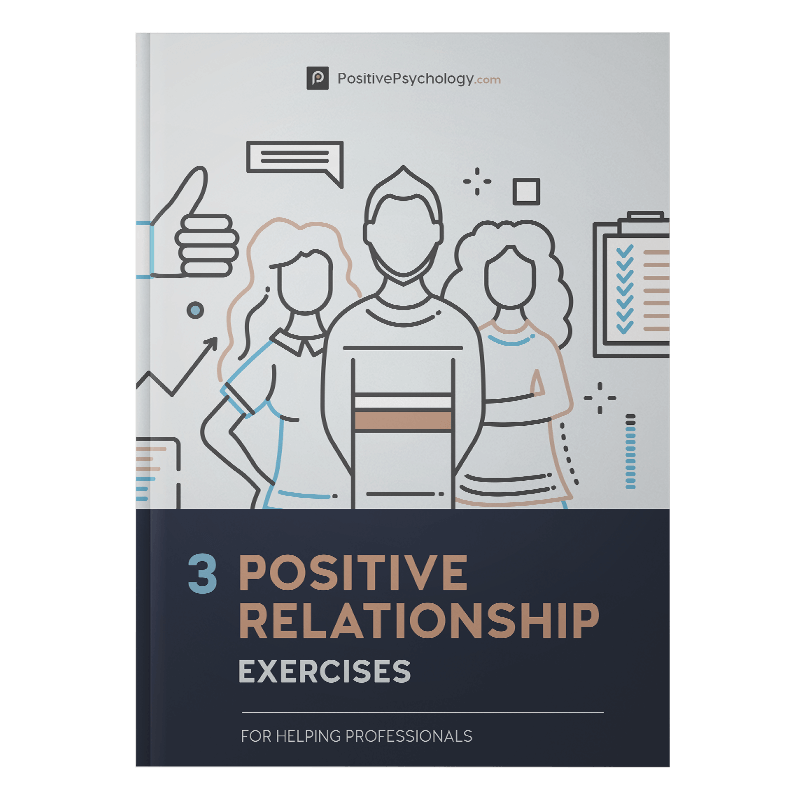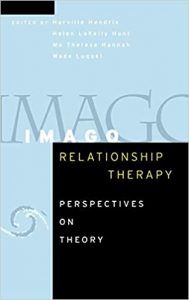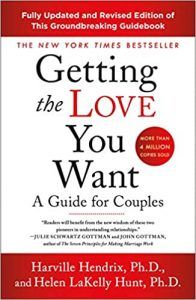14 Imago Therapy Worksheets, Examples, and Techniques
 The morning after he received his divorce papers, Harville Hendrix was teaching a psychotherapy class when one of his students asked why relationships were so tricky (Hannah, Luquet, Hendrix, Hunt, & Mason, 2005).
The morning after he received his divorce papers, Harville Hendrix was teaching a psychotherapy class when one of his students asked why relationships were so tricky (Hannah, Luquet, Hendrix, Hunt, & Mason, 2005).
While admitting he had no clue, he committed to finding an answer for personal and professional reasons. And so began a search that led to a change of career and the start of a new type of couple counseling, later called Imago Relationship Therapy (IRT).
This article explores Imago therapy’s theories and techniques, and introduces some essential exercises and useful worksheets.
Before you continue, we thought you might like to download our three Positive Relationships Exercises for free. These detailed, science-based exercises will help you or your clients build healthy, life-enriching relationships.
This Article Contains:
- Imago Therapy Explained
- Does Imago Relationship Therapy Work?
- 3 Common Criticisms of Imago Therapy
- 5+ Imago Therapy Techniques
- 3 Exercises for Your Sessions
- 6 Helpful Worksheets
- Training in Imago Therapy: 3 Options
- Books on the Topic
- PositivePsychology.com’s Relevant Resources
- A Take-Home Message
- References
Imago Therapy Explained
IRT was created by Harville Hendrix in the late 1970s and popularized in his bestselling 1988 book Getting the Love You Want: A Guide for Couples (Hendrix & Hunt, 1988).
A synthesis of both old and new, IRT combines the best elements of classical psychotherapy and the idea of a natural healing process into marriage and relationship counseling (Hannah et al., 2005; Hendrix & Hunt, 1988).
But why do relationships go wrong?
Early in a relationship, romantic love is all consuming. It provides a heady cocktail of hope and passion, mixed with loss of individuality and confusion. The release of the brain stimulant phenylethylamine leads to feelings of euphoria and elation, accompanied by a myriad of other hormonal changes (Marazziti & Canale, 2004; Savulescu & Sandberg, 2008).
Love is viewed within IRT as nature’s way of putting together two (often) emotionally wounded people who most likely share a vulnerability to heal their wounds and form a whole (Luquet, 2015).
Our brain is like a warehouse, full of unconscious images (imago in Latin) of both positive and negative events from our childhood. And we all too often confuse the frustration of the present with that of the past.
When couples form, they experience feelings of safety. Yet, as the romantic love fades, so can their feelings of security, leaving the partners with options to fight or flee.
IRT is concerned with growth and moving on from such feelings – essential for a couple to do the work needed to mend their relationship.
Ultimately, according to Wade Luquet, couples in a long-lasting relationship must come to terms with the fact that romantic love – in abundance at the beginning of their relationship – was temporary.
Instead, it is time to work toward something more authentic and enduring (Luquet, 2015).
Does Imago Relationship Therapy Work?

Recent psychological studies have confirmed the importance of therapies that focus on communication and interpersonal skills to improve relationship satisfaction and reduce distress (Schmidt & Gehlert, 2016).
The existence of more than 1,000 Imago therapists practicing in over 30 countries worldwide suggests the approach’s value. And several controlled studies have reported significant increases in empathy and marital satisfaction in couples who have received IRT over multiple weeks (Schmidt & Gehlert, 2016; Gehlert, Schmidt, Giegerich, & Luquet, 2017).
However, no significant clinical differences were found when results were compared with control groups that didn’t go through IRT (Gehlert et al., 2017).
Small sample sizes hamper the limited research into the effectiveness of IRT, and, other than through anecdotal observation, it is not possible to confirm the degree of effectiveness of IRT.
Imago therapy: how to communicate better in relationships – Monika Hoyt
3 Common Criticisms of Imago Therapy
IRT aims to restore and re-establish loving relationships by improving empathy and communication. The therapist is less the director of healing and more there to assist the process (Hannah et al., 2005).
The therapy is unlikely to be suitable for couples going through domestic violence, substance abuse, or other addictive behaviors. It may also not be appropriate for relationships where one or both partners are experiencing unrelated mental health problems (Lipthrott, 2016; Harryman, 2008).
Imago therapy has its roots in (Jungian) psychoanalysis, which has been challenged for its overwhelming focus on personality development in childhood rather than as a lifelong journey. And while Jungian and Freudian theories are fascinating, they cannot explain either universal characteristics or individual differences and what makes us unique (Larsen, Buss, Wismeijer, & Song, 2017; Myers, 2010).
5+ Imago Therapy Techniques

- Defense against the loss of romantic love
Couples must recognize that romantic love is temporary. However, shared experiences and weathering difficulties in life can grow a love that is stronger and more enduring. - Healing the wounds created during the development process
IRT suggests that damage can occur at any stage of personality development due to a lack of appropriate support (Luquet, 2015; Erikson & Erikson, 1982).
As a result, we often become attracted to people wounded at the same point developmentally who failed to learn healthy psychological responses.
We may fall for partners who cannot give us what we need.
- Restoring functions lost during the socialization process
IRT describes humans as expressing astronomical energy from an explosion that began 15 billion years ago “through our thinking, feeling, acting, and sensing” (Luquet, 2015).
However, while we are born with the potential to be whole, the environment and past events may have stopped us. For example, hearing negative statements such as “boys don’t cry” or “you never do anything right,” may inhibit our ability to “act” as a means of expressing energy (Luquet, 2015).
Only through recovering what we have lost during development can we regain our whole and access all of our cosmological energy for expression. Our goal to become whole can be seen in our choice of partner, as they often appear to possess part of our lost self.
Yet in time, we often start to resent those parts that first attracted us and try to fix them. Instead, we must make ourselves whole by growing those parts of us that we had sought in our partner.
So, how do we restore our whole?
According to IRT, nature has put together:
- Two incompatible people
- Each injured at the same place developmentally
- Each missing essential parts
Rather than fix things, we tend to break them further to defend ourselves. Instead, we must regain our wholeness through cooperation.
IRT asks for a commitment from both partners to make the relationship work and restore their wholeness. And while it can be painful, techniques can help, such as:
- Creating safety
The older parts of our brains are highly reactive, so it can be useful to find somewhere in our minds where we feel safe to begin the process – real or imagined.
We can visit this place while remaining fully present during therapy, especially during uncomfortable conversations.
- Improving dialogue
Dialogue is crucial to Imago and the future happiness of the couple.
Couples dialogue involves repeating back what was actually said rather than what the listener interpreted. This process, known as mirroring, shows the partner that they were heard.
Then the listener validates by placing themselves in the speaker’s shoes and attempting to understand events from their perspective. By imagining their feelings, it is possible to create empathy.
Creating safety and couples dialogue provide the tools required to continue onward to the real work.
Next, we need a way to communicate frustrations and feelings effectively.
- Behavior change requests
Provide opportunities to ask for change, based on the sender’s frustrations. They must be worded carefully so that the receiver can both hear and respond.
Together such requests form a blueprint for growth and a chance to become whole by reclaiming previously lost parts (Luquet, 2015).
For example, “My job is very stressful at the moment, I need you to listen and validate how hard it is and to think about how I may be feeling.”
The change request clarifies the partner’s needs but is usually asking for the most difficult thing for them to give. “That need is requesting something of the receiving partner’s lost part” (Luquet, 2015).
How do we effectively communicate when we are angry at the other person?
IRT offers two approaches to help:
- Reimagining your partner
Couples tend to dehumanize one another using pronouns, such as “you always…,” “she never…,” and “he is…” rather than using names.
It is essential to start seeing the partner as an ally rather than an enemy. The relationship is a vehicle for growth, not a mistake from the past.
The couple is encouraged to remember that problems in a relationship are only partly about now and significantly about “the house they grew up in” (Luquet, 2015).
- The container process
A couple typically expresses anger in a relationship loudly or not at all.
When one partner does not express their anger, the other can become frustrated. And when it is let loose, the other person may freeze or hide.
IRT encourages recognition of that anger and finds a way to make it safe to be heard.
The container process involves making an appointment and scheduling time to express that anger safely and in a controlled way.
Providing enough warning makes the other person ready and allows them to find their safe place to hear the anger and ultimately reach into the pain beneath.
3 Exercises for Your Sessions
The following IRT exercises build on the empathy and feelings of safety described in the techniques above (Luquet, 2015):
The holding position
Imago therapy views a couple as, at times, surrogate parents. It means each person can receive what they missed as children.
Physically holding one another can be a powerful exercise for building empathy and trust.
One person sits at the end of a sofa holding the partner with their head on their lap. The person cradled is then asked to talk about what it was like for them when they were little.
The exercise forms an increasing bond as the holder feels a sense of nurture for the partner held.
Little surprises exercise
The little things we do for each other are incredibly special yet quickly become part of a routine. The morning cup of tea becomes less of a gift and more something expected.
Instead, a relationship can benefit from a list of firsts. An unexpected meal, a note left on the fridge door, and responding to something mentioned earlier in the week shows you are hearing your partner’s needs and keeps them on the edge of happy anticipation.
Belly laughs exercise
All relationships can benefit from having fun, and yet it can be easily forgotten.
Luquet (2015) offers the following silly suggestions to introduce “sustained belly laughs” and a release of feel-good endorphins:
- Butterfly kiss
The couple moves their faces close together so that when they blink, their eyelashes tickle each other. - I can do that
The couple stands facing one another. One partner moves their body and says, “I can do this, can you do this?” The other repeats the action and adds a new one.
The game continues until both are unable to keep adding to the sequence and often leads to giggles and laughter.
Ultimately the game itself does not matter. The laughter, joy, and learning to be fun together is what is important.
6 Helpful Worksheets

Finding Your Imago
Your clients must build a clear picture of how they felt about their childhood and the environment in which they grew up.
Ask them to recall their caretakers’ (carers’) positive and negative traits and write them down in the Finding Your Imago worksheet.
Then ask the client to write down what they would like to say to each caretaker, such as “I wanted you to show that you loved me,” or “I loved it when you used to take me on picnics.”
Childhood Frustrations
Use the Childhood Frustrations worksheet to build a picture of the frustrations your clients felt during their childhood and how they reacted.
Positive Memories of Childhood
While it is important to remember what was difficult in our childhood, it is equally important to remember what was good.
Use the Positive Memories of Childhood worksheet to capture some happy memories such as, “I remember the family get-togethers at Christmas,” or “I remember my tenth birthday party.”
My Imago
Our childhood can strongly influence who we choose as a partner and how we handle difficulties in our relationships.
Complete the My Imago worksheet to understand how our childhood can influence the current relationship.
Mutual Relationship Vision
The Mutual Relationship Vision worksheet should be completed individually for both partners in the relationship and then shared and discussed.
Working together, complete the “Our dream relationship” section to capture a shared vision of how the ideal relationship would look.
Caring Behaviors List
Do you know what you do in your relationship that has special meaning for your partner? And do you know what they would like you to do?
Use the Caring Behaviors List worksheet to capture what you should keep doing and what would make your relationship even better.
Training in Imago Therapy: 3 Options
There are several opportunities worldwide for engaging in IRT training.
- The Imago International Training Institute provides clinical and facilitator training in IRT worldwide.
- Imago Relationships provides training in IRT theory and its practical application for clinical practitioners.
- Dr. Kalanit Ben-Ari offers Clinical IRT Training over 96 hours (12 days) as part of a six-month program of supervision.
Books on the Topic
Below is a short selection of recommended Imago books, from challenging to lighter reads.
1. Imago Relationship Therapy: Perspectives on Theory – Mo Therese Hannah, Wade Luquet, Harville Hendrix, Helen LaKelly Hunt, and Randall C. Manson
This book offers an in-depth explanation of the Imago approach to relationship therapy. However, due to its depth and complexity, it is not for the faint hearted.
The authors take the reader through a full breakdown of Imago’s theory and its relationship with other schools of thought.
Find the book on Amazon.
2. Getting the Love You Want: A Guide for Couples – Harville Hendrix and Helen LaKelly Hunt
The third edition of this New York Times bestseller is recommended for both therapists and couples wishing to find ways of improving relationships.
This well-written guidebook combines behavioral science, psychology, and social learning theory to provide tried-and-tested tools for enhancing relationships.
Find the book on Amazon.
3. Short-Term Couples Therapy – Wade Luquet
This excellent book is a mainstay for relationship counselors interested in learning IRT.
It provides not only an explanation of the theory, but also essential session plans and a range of tools for working with couples therapy.
Find the book on Amazon.
PositivePsychology.com’s Relevant Resources
We have many tools available for working with couples to improve communication and build empathy.
Why not try out some of the following with your clients?
- Relationship Qualities Worksheet – This excellent worksheet encourages couples to build up a bank of positive feelings and list of activities to re-visit together.
- Valuing My Partner Worksheet – This resource invites couples to consider the qualities, shared memories, and what they value in their partner to see their relationship in a more positive light.
- Creating a Connection Ritual – Including steps to help couples schedule time and activities together.
- Understanding the Big Picture – Appreciating one another’s big dreams is crucial to the overall quality of an intimate relationship.
- Capitalizing Positive Emotions With Active Constructive Responding – Can help couples learn to share positive events with one another and create a healthy, lasting bond.
If you’re looking for more science-based ways to help others build healthy relationships, this collection contains 17 validated positive relationships tools for practitioners. Use them to help others form healthier, more nurturing, and life-enriching relationships.
A Take-Home Message
According to IRT, nature provides relationships to heal the wounds left by our childhood and as an opportunity to continue our growth (Hannah et al., 2005).
Many of the frustrations we face as a couple are only partially related to the here and now and strongly connected to the environment in which we grew up.
For IRT to work, the couple must move away from old brain responses and trust the process of therapy, relying on the tools and techniques that are introduced (Luquet, 2015).
For a couple to be successful, it does not require that two become one. Instead, a good relationship consists of two individuals with a healthy dialogue that builds strong interdependent relationships.
Explore IRT as an approach with your clients. It offers some practical advice and realistic strategies for a couple to recognize each other as allies, rather than enemies, and overcome the inevitable difficulties faced, creating a robust and enduring love.
We hope you enjoyed reading this article. Don’t forget to download our three Positive Relationships Exercises for free.
- Erikson, E. H., & Erikson, J. M. (1982). The life cycle completed. W.W. Norton.
- Gehlert, N. C., Schmidt, C. D., Giegerich, V., & Luquet, W. (2017). Randomized controlled trial of Imago relationship therapy: Exploring statistical and clinical significance. Journal of Couple & Relationship Therapy, 16(3), 188–209.
- Hannah, M. T., Luquet, W., Hendrix, H., Hunt, H., & Mason, R. C. (2005). Imago relationship therapy: Perspectives on theory. Jossey-Bass/A Wiley Imprint.
- Harryman, W. (2008). Imago therapy – A critique & a proposal. Integral Options Cafe. Retrieved December 5, 2020, from http://integral-options.blogspot.com/2008/03/imago-therapy-critique-proposal.html
- Hendrix, H., & Hunt, H. (1988, 2019). Getting the love you want: A guide for couples. Holt & Company, Henry.
- Larsen, R., Buss, D., Wismeijer, A., & Song, J. (2017). Personality psychology: Domains of knowledge about human nature. McGraw-Hill Education.
- Lipthrott, D. J. (2016). What IS Imago relationship therapy Pt. 1. Relationship Learning Ctr. Retrieved from http://www.relationshipjourney.com/imagotherapy.html
- Luquet, W. (2015). Short-term couples therapy: The Imago model in action. Routledge.
- Marazziti, D., & Canale, D. (2004). Hormonal changes when falling in love. Psychoneuroendocrinology, 29(7), 931–936.
- Myers, D. (2010). Psychology in modules: Personality. Worth Publishers.
- Savulescu, J., & Sandberg, A. (2008). Neuroenhancement of love and marriage: The chemicals between us. Neuroethics, 1(1), 31–44.
- Schmidt, C. D., & Gehlert, N. C. (2016). Couples therapy and empathy: An evaluation of the impact of Imago relationship therapy on partner empathy levels. The Family Journal, 25(1), 23–30.
Read other articles by their category
- Body & Brain (50)
- Coaching & Application (57)
- Compassion (26)
- Counseling (51)
- Emotional Intelligence (24)
- Gratitude (18)
- Grief & Bereavement (21)
- Happiness & SWB (40)
- Meaning & Values (26)
- Meditation (20)
- Mindfulness (45)
- Motivation & Goals (45)
- Optimism & Mindset (34)
- Positive CBT (29)
- Positive Communication (20)
- Positive Education (47)
- Positive Emotions (33)
- Positive Leadership (18)
- Positive Parenting (4)
- Positive Psychology (33)
- Positive Workplace (37)
- Productivity (17)
- Relationships (46)
- Resilience & Coping (38)
- Self Awareness (21)
- Self Esteem (38)
- Strengths & Virtues (32)
- Stress & Burnout Prevention (34)
- Theory & Books (46)
- Therapy Exercises (37)
- Types of Therapy (64)








